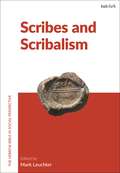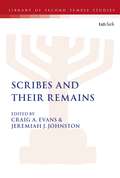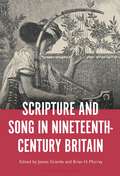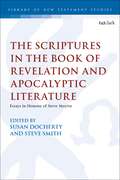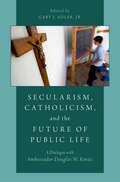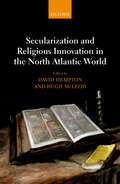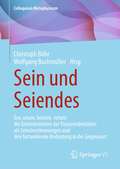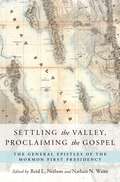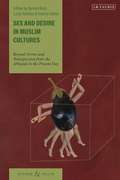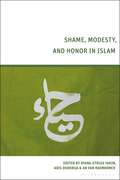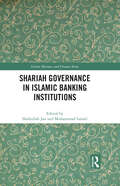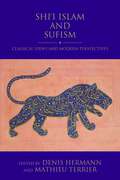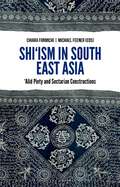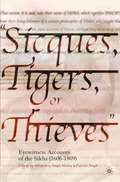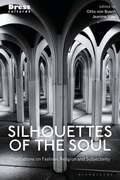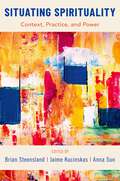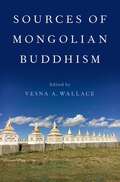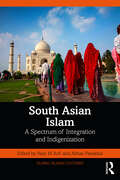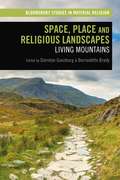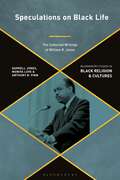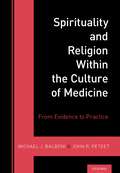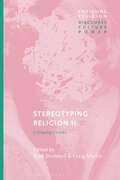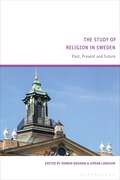- Table View
- List View
Scribes and Scribalism (The Hebrew Bible in Social Perspective)
This volume is a concentrated examination of the varied roles of scribes and scribal practices in ancient Israel and Judah, shedding light on the social world of the Hebrew Bible. Divided into discussion of three key aspects, the book begins by assessing praxis and materiality, looking at the tools and materials used by scribes, where they came from and how they worked in specific contexts. The contributors then move to observe the power and status of scribal cultures, and how scribes functioned within their broader social world. Finally, the volume offers perspectives that examine ideological issues at play in both antiquity and the modern context(s) of biblical scholarship. Taken together, these essays demonstrate that no text is produced in a void, and no writer functions without a network of resources.
Scribes and Their Remains (The Library of Second Temple Studies)
Scribes and Their Remains begins with an introductory essay by Stanley Porter which addresses the principal theme of the book: the text as artifact. The rest of the volume is then split into two major sections. In the first, five studies appear on the theme of 'Scribes, Letters, and Literacy.' In the first of these Craig A. Evans offers a lengthy piece that argues that the archaeological, artifactual, and historical evidence suggests that New Testament autographs and first copies may well have remained in circulation for one century or more, having the effect of stabilizing the text. Other pieces in the section address literacy, orality and paleography of early Christian papyri. In the second section there are five pieces on 'Writing, Reading, and Abbreviating Christian Scripture.' These range across numerous topics, including an examination of the stauros (cross) as a nomen sacrum. The volume concludes with reflections by co-editor Peter Arzt-Grabner incorporating his longstanding expertise in the study of documentary papyri, especially as these ancient documents relate to New Testament research. From the perspective of a papyrologist, Arzt-Grabner discusses how New Testament scholars use documentary papyri today and recommends some future directions.
Scripture and Song in Nineteenth-Century Britain
This volume brings together new approaches to music history to reveal the interdependence of music and religion in nineteenth-century culture. As composers and performers drew inspiration from the Bible and new historical sciences called into question the historicity of Scripture, controversies raged over the performance, publication and censorship of old and new musical forms. From oratorio to opera, from parlour song to pantomime, and from hymn to broadside, nineteenth-century Britons continually encountered elements of the biblical past in song. Both elite and popular music came to play a significant role in the formation, regulation and contestation of religious and cultural identity and were used to address questions of class, nation and race, leading to the beginnings of ethnomusicology. This richly interdisciplinary volume brings together musicologists, historians, literary and art historians and theologians to reveal points of intersection between music, religion and cultural history.
The Scriptures in the Book of Revelation and Apocalyptic Literature: Essays in Honour of Steve Moyise (The Library of New Testament Studies)
This volume addresses one of the key issues in the study of the Book of Revelation and the apocalyptic genre more broadly – the re-use within these texts of the Jewish Scriptures. A range of expert contributors analyse specific themes and passages, and also explore wider methodological questions, aiming particularly to engage with the ground-breaking work in this field of Steve Moyise.Divided into three sections, the book first focuses on hermeneutical questions, such as the role of 'typology' in interpretation, and the relationship between the 'original meaning' of a scriptural text and the sense it acquires in a new literary context. In the following section, a series of chapters offers detailed exegetical engagement with the Book of Revelation. These probe the scriptural background of some of its major theological themes (e.g. time, sounds and silence) and significant passages (e.g. the Song of the Lamb and other hymns), and highlight fresh aspects of its reception by both ancient and modern audiences. The final section considers the place of scripture and its interpretation in a selection of other early Jewish and early Christian apocalyptic writings (including 1 Enoch, Paul's Letters and the First Apocryphal Apocalypse of John).
Secularism, Catholicism, and the Future of Public Life: A Dialogue with Ambassador Douglas W. Kmiec
How can religion contribute to democracy in a secular age? And what can the millennia-old Catholic tradition say to church-state controversies in the United States and around the world? Secularism, Catholicism, and the Future of Public Life, organized through the work of the Institute for Advanced Catholic Studies (www.ifacs.com), responds to these questions by presenting a dialogue between Douglas W. Kmiec, a leading scholar of American constitutional law and Catholic legal thought, and an international cast of experts from a range of fields, including legal theory, international relations, journalism, religion, and social science.
Secularization and Religious Innovation in the North Atlantic World
In the early twenty-first century it had become a cliché that there was a 'God Gap' between a more religious United States and a more secular Europe. The apparent religious differences between the United States and western Europe continue to be a focus of intense and sometimes bitter debate between three of the main schools in the sociology of religion. According to the influential 'Secularization Thesis', secularization has been an integral part of the processes of modernisation in the Western world since around 1800. For proponents of this thesis, the United States appears as an anomaly and they accordingly give considerable attention to explaining why it is different. For other sociologists, however, the apparently high level of religiosity in the USA provides a major argument in their attempts to refute the Thesis. Secularization and Religious Innovation in the Atlantic World provides a systematic comparison between the religious histories of the United States and western European countries from the eighteenth to the late twentieth century, noting parallels as well as divergences, examining their causes and especially highlighting change over time. This is achieved by a series of themes which seem especially relevant to this agenda, and in each case the theme is considered by two scholars. The volume examines whether American Christians have been more innovative, and if so how far this explains the apparent 'God Gap'. It goes beyond the simple American/European binary to ask what is 'American' or 'European' in the Christianity of the nineteenth and twentieth centuries, and in what ways national or regional differences outweigh these commonalities.
Secularization and the World Religions
The question of religion, its contemporary and future significance and its role in society and state is currently perceived as an urgent one by many and is widely discussed within the public sphere. But it has also long been one of the core topics of the historically oriented social sciences. The immense stock of knowledge furnished by the history of religion and religious studies, theology, sociology and history has to be introduced into the public conscience today. This can promote greater awareness of the contemporary global religious situation and its links with politics and economics and counter rash syntheses such as the “clash of civilizations”. This volume is concerned with the connections between religions and the social world and with the extent, limits, and future of secularization. The first part deals with major religious traditions and their explicit or implicit ideas about the individual, social and political order. The second part gives an overview of the religious situation in important geographical areas. Additional contributions analyze the legal organization of the relationship between state and religion in a global perspective and the role of the natural sciences in the process of secularization. The contributors are internationally renowned scholars like Winfried Brugger, José Casanova, Friedrich Wilhelm Graf, Hans Joas, Hans G. Kippenberg, Gudrun Krämer, David Martin, Eckart Otto and Rudolf Wagner.
Sein und Seiendes: Ens, unum, bonum, verum: die Erkenntnislehre der Transzendentalien als Seinsbestimmungen und ihre fortwirkende Bedeutung in der Gegenwart (Colloquium Metaphysicum)
Das Eine, das Gute, das Wahre und das Schöne – unum, bonum, verum, pulchrum – werden in der hochmittelalterlichen Philosophie als allgemeine Bestimmungen eines ungegenständlichen Seins, dessen erkennbare Spur sich in allem gegenständlich Seienden findet, verstanden. Weil diese Bestimmungen alle besonderen Seinsweisen übersteigen, werden sie ‚Transzendentalien‘ oder ‚Communissima‘ genannt: das, was allen Dingen gemeinsam ist. Der Sinn dieser Logik erschließt sich, wenn wir die Erkenntnis des jeweils Seienden, der Einzeldinge, in deren Anteilsbeziehung zum schlechthinnigen Sein – in dem sich das Eine, Gute, Wahre und Schöne verbinden – begreifen. Eben dazu will uns diese Denkform, die unter anderem auf Aristoteles zurückgeht und um die unter den Philosophen des Mittelalters gerungen wurde, anleiten; sie blieb bis in die Neuzeit maßgeblich als das Herz der europäischen Metaphysik. Heute ist uns dieses Denken fremd geworden. Man muss es sich aber vor Augen führen, um die mittelalterliche Philosophie, zu der die Neuzeit trotz aller Diskontinuitäten in weit engerer Verbindung steht, als uns allermeist bewusst ist, verstehen zu können. Zudem war die Logik der Transzendentalien nicht nur philosophiehistorisch wirksam, sondern eine Erkenntnislehre, die ihre fortwirkende Bedeutung bis heute behalten hat und deshalb eine Vergegenwärtigung verdient.
Settling the Valley, Proclaiming the Gospel: The General Epistles of the Mormon First Presidency
The Mormons had just arrived in Utah after their 1,300-mile exodus across the Great Plains and over the Rocky Mountains. Food was scarce, the climate shocking in its extremes, and local Indian bands uneasy. Despite the challenges, Brigham Young and his counselors in the First Presidency sent church members out to establish footholds throughout the Great Basin. But the church leaders felt they had a commission to do more than simply establish Zion in the wilderness; they had to invite the nations to come up to "the mountain of the Lord's house." In these critical early years, when survival in Utah was precarious, missionaries were sent to every inhabited continent. The 14 general epistles, sent out from the First Presidency from 1849 to 1856, provide invaluable perspectives on the events of Mormon history as they unfolded during this complex transitional time. Woven into each epistle are missionary calls and reports from the field, giving the Mormons a glimpse of the wider world far beyond their isolated home. At times, the epistles are a surprising mixture of soaring doctrinal expositions and mundane lists of items needed in Salt Lake City, such as shoe leather and nails. Settling the Valley, Proclaiming the Gospel collects the 14 general epistles, with introductions that provide historical, religious, and environmental contexts for the letters, including how they fit into the Christian epistolary tradition by which they were inspired.
Sex and Desire in Muslim Cultures: Beyond Norms and Transgression from the Abbasids to the Present Day (Gender and Islam)
What have different ideas about sex and gender meant for people throughout the history of the Middle East and North Africa? This book traces sex and desire in Muslim cultures through a collection of chapters that span the 9th to 21st centuries. Looking at spaces and periods where sexual norms and the categories underpinning them emerge out of multiple subjectivities, the book shows how people constantly negotiate the formulation of norms, their boundaries and their subversion. It demonstrates that the cultural and political meanings of sexualities in Muslim cultures - as elsewhere – emerge from very specific social and historical contexts.The first part of the book examines how people constructed, discussed and challenged sexual norms from the Abbasid to the Ottoman period. The second part looks at literary and cinematic Arab cultural production as a site for the construction and transgression of gender norms. The third part builds on feminist historiography and social anthropology to question simplistic dichotomies and binaries. Each of the contributions shows how understanding of sexualities and the subjectivities that evolve from them are rooted in the mutually-constitutive relationships between gender and political power. In identifying the plurality of discourses on desires, the book goes beyond the dichotomy of norm and transgression to glimpse what different sexual norms have meant at different times across the Middle East.
Shame, Modesty, and Honor in Islam
With a particular emphasis on definitions, continuities, and change, this edited volume examines the historical role and function of haya' – or feelings of shame, modesty, and honor – in Islamic theology and law, and explores contemporary Muslims' engagements with the concept. The book explores various conceptions of haya' and the practices associated with the concept in both Muslim majority and minority contexts. The empirically rich contributions reveal how haya' is socially constructed in varying social and cultural environments across the globe. From medieval Islam to the modern day, this book demonstrates the importance of haya' and its temporal and spatial transformations.
Shariah Governance in Islamic Banking Institutions (Islamic Business and Finance Series)
Shariah governance assumes the primary instrument through which Islamic Banking Institutions (IBIs) ensure the Islamicity of their products, services, operations, and internal environments. It is considered to be one the fundamental elements that differentiates IBIs from their traditional counterparts. Shariah Governance in Islamic Banking Institutions provides a critical overview of the key aspects pertaining to Shariah governance within Islamic financial institutions and presents a detailed analysis of its conceptual background. The authors have identified the unique issues that have emerged due to the integration of Shariah, namely the involvement of the Shariah supervisory board (SSB), in the corporate governance arrangements of Islamic banks. These issues relate to disclosure, transparency, independency, consistency, confidentiality, competency, and reputation. The book details the doctrines of Shariah pronouncements in Islamic banks, the importance of having a central advisory board at a regulatory level in the standardization of Islamic banking practices, as well as the competence required for Shariah supervisory board members. It provides a critical analysis of the Shariah governance framework in Pakistan and introduces the authors’ vision of an ideal Shariah governance framework. Furthermore, the chapters offer guidance in promoting effective policies for improving Shariah governance. This is one of the core challenges facing Islamic banks, namely, to ensure compliance with faith and provide legitimacy to the business of IBIs, and as such, the book will appeal to both the research and professional communities.
Shi'i Islam and Sufism: Classical Views and Modern Perspectives (Shi'i Heritage Series)
Offering new perspectives on the relationship between Shi'is and Sufis in modern and pre-modern times, this book challenges the supposed opposition between these two esoteric traditions in Islam by exploring what could be called "Shi'i Sufism" and "Sufi-oriented Shi'ism" at various points in history. The chapters are based on new research in textual studies as well as fieldwork from a broad geographical areas including the Indian subcontinent, Anatolia and Iran. Covering a long period stretching from the early post-Mongol centuries, throughout the entire Safawid era (906–1134/1501–1722) and beyond, it is concerned not only with the sphere of the religious scholars but also with different strata of society. The first part of the volume looks at the diversity of the discourse on Sufism among the Shi'i "ulama" in the run up to and during the Safawid period. The second part focuses on the social and intellectual history of the most popular Shi'i Sufi order in Iran, the Ni'mat Allahiyya. The third part examines the relationship between Shi'ism and Sufism in the little-explored literary traditions of the Alevi-Bektashi and the Khaksariyya Sufi order. With contributions from leading scholars in Shi'ism and Sufism Studies, the book is the first to reveal the mutual influences and connections between Shi'ism and Sufism, which until now have been little explored.
Shi'ism In South East Asia: Alid Piety and Sectarian Constructions
This is the first work available in any language to extensively document and critically discuss traditions of 'Alid piety and their modern contestations in the region. The concept of 'Alid piety allows for a reframing of our views on the widespread reverence for 'Ali, Fatima and their progeny that emphasizes how such sentiments and associated practices are seen as part of broad traditions shared by many Muslims, which might or might not have their origins in a specifically Shi'a identity. In doing so, it facilitates the movement of academic discussions out from under the shadow of polemical sectarian discourses on 'Shi'ism' in Southeast Asia. The chapters include presentations of new material from previously unpublished early manuscript sources from Muslim vernacular literatures in the Malay, Javanese, Sundanese, Acehnese and Bugis languages, as well as rich new ethnography from across the region. These studies engage with cultural, intellectual, and performative traditions, as well as the ways in which 'Alid piety has been transformed in relation to more strictly sectarian identifications since the Iranian revolution in 1979.
Sicques, Tigers or Thieves: Eyewitness Accounts of the Sikhs (1606-1810)
In 1812, Sir John Malcolm, a Lieutenant General in the British Army wrote A Sketch of the Sikhs , commonly believed to be the first account of the Sikhs written by a non-Sikh. In truth, soldiers, travellers, diplomats, missionaries and scholars had provided accounts for many years before. Drawing on this difficult-to-access material, the editors of this volume have compiled a unique source that offers a fascinating insight into the early developments in Sikh history. From the first ever written accounts of the Sikhs by Persian chroniclers of the Moghul Emperor to the travel diary of an Englishwoman, this volume contains material invaluable to those studying the evolution of the Sikh religion as well as to those interested in learning more about this major religion. It also provides an unparalleled look into the growth and solidification of the religious practices of Sikhs. At a time when the misunderstanding of the Sikh religion and those who practise it has reached new and deadly heights, this volume hopes to introduce a wider audience to the roots of its culture. For more detailed information, including examples of illustrations, and selected extracts, go to www.sicques.com
Silhouettes of the Soul: Meditations on Fashion, Religion, and Subjectivity (Dress Cultures)
What is the relationship between the soul, or inner life, and what we wear in the making of identity and belief? What bearing do religious and political belonging, respectability, and resistance have on the way in which we dress? Why have more traditional religious practices been so prescriptive about body adornment? Historically, fashionable dress and religion have been positioned as polar opposites. Silhouettes of the Soul brings them together, placing them in conversation with each other. By moving beyond traditional, social scientific, and historical analysis of religious attire and adornment the book presents a variety of disciplinary approaches from across regional, social, and religious locations.Contentious and challenging, as well as academically rigorous, the book's diverse range of contributors - from fashion and religious studies scholars, to designers, activists, monastics, and journalists - explore the relationship between religion and fashion, extending the meanings and possibilities of both dress and spirituality. Combining interviews and personal stories with more traditional theoretical analysis, Silhouettes of the Soul offers new ways of looking at the relationship between religion, personal convictions, and self-expression - our sense of self and our sense of fashion.
Situating Spirituality: Context, Practice, and Power
Spirituality is in the spotlight. While levels of religious belief and observance are declining in much of the Western world, the number of people who identify as "spiritual but not religious" is on the rise. Practices such as yoga, meditation, and pilgrimage are surging in popularity. "Wellness" regimes offer practitioners a lexicon of spirituality and an array of spiritual experiences. Commentators talk of a new spiritual awakening "after religion." And global mobility is generating hybrid practices that blur the lines between religion and spirituality. The essays collected in Situating Spirituality: Context, Practice, and Power examine not only individual engagements with spirituality, but they show how seemingly personal facets of spirituality, as well as definitions of spirituality itself, are deeply shaped by religious, cultural, and political contexts. The volume is explicitly cross-national and comparative. The contributors are leading scholars of major global regions: North America, Central America, East Asia, South Asia, Africa and the African Diaspora, Western Europe, and the Middle East. They study not only Christian, Jewish, and Islamic societies, but also non-Abrahamic societies with native as well as transnational sacred traditions.
Sources of Mongolian Buddhism
Despite Mongolia's centrality to East Asian history and culture, Mongols themselves have often been seen as passive subjects on the edge of the Qing formation or as obedient followers of so-called "Tibetan Buddhism," peripheral to major literary, religious, and political developments. But in fact Mongolian Buddhists produced multi-lingual and genre-bending scholastic and ritual works that profoundly shaped historical consciousness, community identification, religious knowledge, and practices in Mongolian lands and beyond. In Sources of Mongolian Buddhism, a team of leading Mongolian scholars and authors have compiled a collection of original Mongolian Buddhist works--including ritual texts, poetic prayers and eulogies, legends, inscriptions, and poems--for the first time in any European language.
South Asian Islam: A Spectrum of Integration and Indigenization (Global Islamic Cultures)
This volume explores the historical trajectory of the spread of Islam in South Asia and how the engagements of the past have played a crucial role in the making of the present outfits of South Asian Islam. Islam in South Asia has maintained a distinct role while imbibing cultural, social, ethnic, folk, and artistic networks of the subcontinent in diverse echelons. In an unequivocal analysis, this volume showcases the visible varieties of Islam from an array of regional cultural, ethnic, and vernacular groups. While many characteristics remain distinct in different provinces or regions of South Asia, similarities are palpable in etiquettes, customary laws, art, and architecture. More than regional differences, various ethnic groups from all poles of the Indian subcontinent have paved the way for the dissimilar landscapes of Islam, in tandem with differences in language, culture, and festivals. The case studies in this book exhibit forms of cultural pluralism in the communities, which have helped in building a cohesive community. Part of the ‘Global Islamic Cultures’ series that looks at integrated and indigenized Islam, this book will be of interest to students and researchers of religion, religious history, theology, study of Islamic law and politics, cultural studies, and South Asian Studies. It will also be useful to general readers who are interested in world religions and cultures.
Space, Place and Religious Landscapes: Living Mountains (Bloomsbury Studies in Material Religion)
Exploring sacred mountains around the world, this book examines whether bonding and reverence to a mountain is intrinsic to the mountain, constructed by people, or a mutual encounter. Chapters explore mountains in England, Scotland, Wales, Italy, Ireland, the Himalaya, Japan, Greece, USA, Asia and the Andes, and embrace the union of sky, landscape and people to examine the religious dynamics between human and non-human entities.This book takes as its starting point the fact that mountains physically mediate between land and sky and act as metaphors for bridges from one realm to another, recognising that mountains are relational and that landscapes form personal and group cosmologies. The book fuses ideas of space, place and material religion with cultural environmentalism and takes an interconnected approach to material religio-landscapes. In this way it fills the gap between lived religious traditions, personal reflection, phenomenology, historical context, environmental philosophy, myths and performativity. In defining material religion as active engagement with mountain-forming and humanshaping landscapes, the research and ideas presented here provide theories that are widely applicable to other forms of material religion.
Speculations on Black Life: The Collected Writings of William R. Jones (Bloomsbury Studies in Black Religion and Cultures)
Is God a white racist? Posed by William R. Jones in his ground-breaking book of the same name, this question disrupted the theological assumptions that marked Black religious thought from early writings of the 1800s to the formation of Black theology in the 1960s. This book compiles his key and essential writings related to over three decades of critical reflection on race, religion, secularism, and oppression in the United States. Over the course of 30 years, Jones pushed questions and considerations that refined Black theology and that gave greater shape to and understanding of Black philosophers' intervention into issues of racial and structural inequality. His philosophical work, related to the grid of oppression, fosters an approach to the nature and meaning of oppression in the United States, encouraging rational interrogation of structures of injustice and thought patterns supporting those structures. Still relevant today, the straightforward style of communication used by Jones makes these essays easily accessible to a popular audience, while maintaining intellectual rigor, making the book also suitable for an academy-based audience.
Spiritual Education: Cultural, Religious and Social Differences (Spirituality in Education)
This selection of papers is the first coherent presentation of spiritual education as a distinctive field of academic enquiry in its own right.
Spirituality and Religion Within the Culture of Medicine: From Evidence to Practice
Spirituality and Religion Within the Culture of Medicine provides a comprehensive evaluation of the relationship between spirituality, religion, and medicine evaluating current empirical research and academic scholarship. In Part 1, the book examines the relationship of religion, spirituality, and the practice of medicine by assessing the strengths and weaknesses of the most recent empirical research of religion/spirituality within twelve distinct fields of medicine including pediatrics, psychiatry, internal medicine, surgery, palliative care, and medical ethics. Written by leading clinician researchers in their fields, contributors provide case examples and highlight best practices when engaging religion/spirituality within clinical practice. This is the first collection that assesses how the medical context interacts with patient spirituality recognizing crucial differences between contexts from obstetrics and family medicine, to nursing, to gerontology and the ICU. Recognizing the interdisciplinary aspects of spirituality, religion, and health, Part 2 of the book turns to academic scholarship outside the field of medicine to consider cultural dimensions that form clinical practice. Social-scientific, practical, and humanity fields include psychology, sociology, anthropology, law, history, philosophy, and theology. This is the first time in a single volume that readers can reflect on these multi-dimensional, complex issues with contributions from leading scholars. In Part III, the book concludes with a synthesis, identifying the best studies in the field of religion and health, ongoing weaknesses in research, and highlighting what can be confidently believed based on prior studies. The synthesis also considers relations between the empirical literature on religion and health and the theological and religious traditions, discussing places of convergence and tension, as well as remainingopen questions for further reflection and research. This book will provide trainees and clinicians with an introduction to the field of spirituality, religion, and medicine, and its multi-disciplinary approach will give researchers and scholars in the field a critical and up-to-date analysis.
Stereotyping Religion II: Critiquing Clichés (Critiquing Religion: Discourse, Culture, Power)
Building on the success of Stereotyping Religion: Critiquing Clichés, this follow up volume dismantles a further 10 widespread stereotypes and clichés about religion, focusing on clichés that a new generation of students are most familiar with. Each chapter includes:- A description of a particular cliché- Discussion of where it appears in popular culture or popular media- Discussion of where it appears in scholarly literature- A historical contextualization of its use in the past- An analysis of the social or rhetorical work the cliché accomplishes in the presentClichés addressed include:- "Religion and science naturally conflict" - "All religions are against LGBTQ rights"- "Eastern religions are more spiritual than Western religions"- "Religion is personal and not subject to government regulation"- "Religious pluralism gives everyone a voice" Written in an easy and accessible style, Stereotyping Religion II: Critiquing Clichés is suitable for all readers looking to clear away unsophisticated assumptions in preparation for more critical studies.
The Study of Religion in Sweden: Past, Present and Future
This book provides a comprehensive examination of the study of religions in Sweden, from the early twentieth century to the present and shows how the intersection of national and social forces shape the study of religion in specific countries and contexts. It traces the establishment of the study of religions as an integrated part of Higher Education in Sweden and it critically examines the development of the most significant disciplines, themes and questions that form Religious Studies in Sweden. Demonstrating the interconnection between nationality and the formation of the academic study of religion, the book explores how Sweden is often described as the most secularised country in the world, yet the study of religions in Sweden has a long, rich, and diverse history. The book emphasizes the interdisciplinary nature of the study of religions, and bring together the voices of 30 scholars.
